
by Somya Devi | Apr 29, 2022 | Astrology, Conjunctions, Eclipses, Events, Holy Days, Planets Changing Signs
Eclipse Season, Venus-Jupiter Conjunction, and Akshaya Tritiya
There is so much going on in the sky right now, this is an exciting time for astronomers and astrologers alike. Tonight brings a Dark Moon as Sun and Moon approach each other for an exact New Moon conjunction on April 30th at 4:28 pm ET. They join in sidereal Aries, where Sun is exalted and Rahu is currently transiting as well. This meeting of Sun, Moon and Rahu stimulates a solar eclipse around the time of the New Moon, the first eclipse of this spring’s eclipse season, with the lunar eclipse following on the Full Moon of May 15th-16th. Additionally, Venus and Jupiter are having their closest conjunction of the year on April 30th as well!
Aries Moon Cycle
The Aries Moon cycle begins when Sun and Moon join in sidereal Aries. If you’ve forgotten the difference between sidereal and tropical systems, here it is! I just re-read this article and definitely recommend checking it out if this is a concept you strive to understand. The Sun is exalted as it travels through Aries, bringing forth a strong sense of vitality and energy as we emerge into the growing season in the northern hemisphere. The Aries cycle is a time for beginning and giving birth to things, just as we see reflected in nature.
Bharani Nakshatra
This Moon cycle begins literally with Sun and Moon in the Vedic nakshatra Bharani, “the bearer,” the star of birth and death. It is represented by a womb, associated with fertile Venus, ruled by death deity Yama, and opens a portal between the worlds of living and dying. This moon cycle is an opportune time to plant the seeds you are wishing to cultivate, both literally and figuratively.
Akshaya Tritiya
Three days after the New Moon in Aries, on Tuesday, May 3rd, the Moon travels through its sign of exaltation as well— Taurus. A sign of exaltation is the place where a planet is considered extremely well-placed, supported by the ruler of that sign, and in good relationship with its home sign. It’s where the planet is most likely to be able to express itself positively through us. With the Sun exalted in Aries, it is supported by its ruler Mars, a planet that adds courage and strength to Sun who seeks to express power and vitality. With the Moon exalted in Venus-ruled, earth-sign Taurus, it gets to rest on fertile and stable ground, an excellent place for our watery, emotional and often changeable mind to reside in the feminine.
With both Sun AND Moon exalted at the same time, this signals that our minds, bodies, and spirit are extremely well-supported. For this reason, this “tritiya” (third waxing Moon) day is thought to be a day that offers only auspicious, prosperous, everlasting results. Hence it is deemed Akshaya Tritiya, “akshaya” being that which is without loss, that which never diminishes. In India this is a major moment for investments, new beginnings, and large purchases, especially of gold and silver. It is thought that your returns will be “never diminishing.”
Although usually I like to offer specific Muhurta selections based on one’s individual natal chart, this day is generally considered auspicious in general for new endeavors, purchases, and investments.
Solar Eclipse
April 30th, the New Moon, itself brings with it a solar eclipse that will be visible from parts of South America and Antarctica. Its effects, however, can be felt across the globe. You may have already noticed tensions rising in your life this week, especially around certain areas where you have felt stuck. Eclipses are when the shadow energy becomes visible (we literally see a shadow when the grahas Rahu and Ketu align with Sun, Moon and Earth). They tend to bring to light areas that require our attention and change, whether it be by eliminating limiting beliefs or patterns, or by stepping into something we have resisted.
This is the first eclipse of a 1.5-year cycle that began when Rahu and Ketu transited into the Aries-Libra axis on April 12th, after their year-and-half transit of Taurus and Scorpio before that. This longer cycle and the biannual eclipse seasons within it are likely to “bring stuff up” for you in whatever areas of life are indicated by Aries and Libra in your Vedic natal chart, and may stimulate other karma depending upon what other planets are there in your chart.
As in many traditional cultures, in Vedic thought eclipses are considered inauspicious times, because the natural order of the universe is turned on its head. It is best not to plan any important activities or new beginnings during the hours of the eclipse itself (2:25 PM – 6:38 PM ET, with maximum eclipse at 4:42). Instead, spiritual practice such as prayer or meditation is advised, as these are the best remedies for dealing with the disruptive, confusing and often virulent energy of the nodes, Rahu and Ketu. Hindu culture advises against eating, drinking or being outside during the eclipse hours as well, especially if you live in its visible path.

This is the first eclipse of two that are coming this eclipse season, the second being a lunar eclipse on the Full Moon of May 15th-16th, which will be visible from most of the Americas, Europe, Africa and the Middle East. After that the eclipse season ends until the next set which will come in October-November of this year.
Some astrologers advise people to do things around an eclipse as these can be transformative times. They can definitely be transformative, but I always caution clients that if you are to make a major decision during an eclipse season, be sure that it comes from a place of clarity, after much reflection and introspection, and that it is not based out of stress, fear, or overwhelm with your current situation.
Jupiter-Venus Conjunction/War
In addition to the New Moon and Solar Eclipse, Saturday also brings the exact conjunction of Jupiter and Venus, at 5:14 pm ET in sidereal Pisces. The two will be traveling together in this sign from April 27th through May 23rd, when Venus moves into Aries. Jupiter is the ruler of Pisces, while Venus is exalted there, giving the two brightest planets a lot of power right now. It will be a beautiful sight to behold on the early mornings of April 30th and May 1st, while they can be seen extremely close together rising a little while before the Sun. (EarthSky has some great visuals on what to look for in the early morning eastern sky.)
The intense proximity of the two, however, creates what is known as a graha yuddha or planetary war in Vedic astrology. This happens whenever two planets come within one degree of each other, as these two do from April 29th through May 1st. When this happens, both planets are considered to be weakened because they must vie with each other for power and our attention. Thus the areas ruled by Jupiter (inspiration, hope, beliefs) and Venus (happiness, romance, art, beauty, nature) in general and in our personal charts, may suffer during this time.
The war between Jupiter and Venus can be particularly difficult as these two are quite inimical to each other, Jupiter being the guru of the Gods and Venus that of the Asuras (demons). Jupiter or Guru guides us to acquire our higher belief systems, knowledge, and wisdom, while Venus or Shukra motivates us mainly towards pleasure. It is for this reason that Venus becomes exalted in Pisces, because when under Jupiter’s influence, in this other-worldly water sign, we are often able to align our desires with a higher power or purpose.
So enjoy the spectacle of the two brightest planets this weekend, but consider the highest potential of the two as you feel the waves of emotion that may come as they battle it out, with the Moon and eclipsed Sun joining Rahu in fiery Aries. Overall I do believe this whole setup offers a lot of potential for inner growth, if we take the time to go inward and seek insight around our highest purpose, desires, and intentions for this season’s new beginnings.

by Somya Devi | Nov 3, 2021 | Astrology, Conjunctions, Eclipses, Holy Days
Diwali New Moon 2021
Thursday, November 4th brings a New moon at 5:15 pm ET and marks the celebration of Diwali, the Hindu festival of lights. As the world outside darkens, we clean our houses and light candles and lamps to celebrate the light, calling in the auspicious blessings of goddess Lakshmi and Lord Rama, gathering with family and friends to share warmth as the season becomes cold.
New Moon in Libra and Swati
This Diwali is marked by the New Moon in sidereal Libra, as Sun and Moon join with both Mars and Mercury there. Libra is a sign about balance, where we seek to bring balance and harmony into our relationships and the outer world. The sky is very imbalanced at this time, however, with eight out of nine grahas clustered on one side of the sky, towards the galactic center.
The four planets join in the Vedic nakshatra of Swati, symbolized by a young sprout blowing in the wind. With Sun debilitated here, it can be easy to lose our center and fall out of balance, especially as the cold vata winds are increasing in the outer atmosphere. This time of year self-care is of utmost importance!
Saturn and Jupiter
Saturn and Jupiter are together again in sidereal Capricorn, with Saturn aspecting the New Moon and putting on the pressure to constrict pleasures and focus on responsibilities. The two together can bring power to some situations, but despite the neecha bhangha yoga being created, Jupiter will be much more comfortable and able to offer more expansive blessings when he transits once again into Aquarius on November 20th.
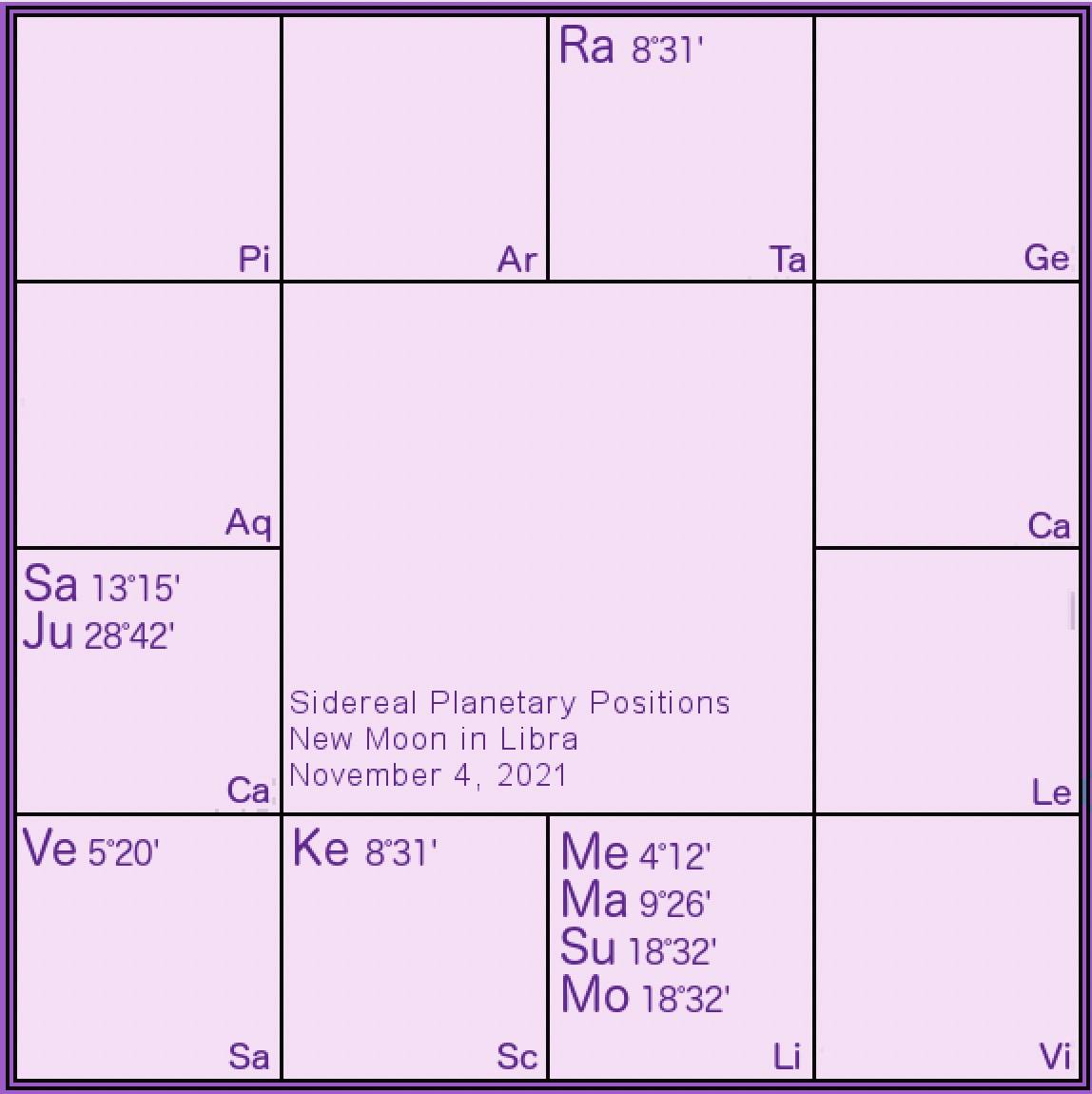
Eclipses
This New Moon actually brings us straight into an eclipse period, with a lunar eclipse occurring on the coming full Moon of November 18th-19th, and a total solar eclipse on the next New Moon of December 4th. Eclipse periods stir up energy from the shadows, making red flags wave bright and bringing the opportunity to navigate discomfort with grace or clumsiness. Depending on your natal chart this could be stimulating change in one particular area of life.
Diwali
On the new Moon of the Hindu month of Ashwin (this month), we celebrate Diwali, the festival of lights. The festival began this year on November 2nd (North America), on the 13th waning Moon phase of the previous cycle. This day is known as Dhanteras, or Dhanvantari Tryodashi, the celebration of the birth of Lord Dhanvantari, the father of Ayurvedic medicine. If you practice any healing tradition, especially Ayurveda, it is a good day to give thanks and call in auspicious blessings to your healing path or practice. Diwali is strongly associated with the Goddess Lakshmi, and is a powerful time to connect with her, calling in her blessings for both material and spiritual prosperity.
We celebrate Diwali while the days are getting noticeably shorter and darker, and it is a time to invite more light into our lives, our hearts, and our world. This festival celebrates the victory of light over darkness, which is something to rejoice in and have faith in, even if we can’t outwardly observe it sometimes. Creating positive vibrations internally is the best way to begin growing and spreading them externally.
Diwali also commemorates Lord Ram’s and Sita’s return from exile after fourteen years (a story from the Ramayana). Lord Ram embodies the highest qualities of dharma, devotion, compassion, courage, and leadership. Diwali is also the start of a new lunar cycle, so it’s a great time to go within and summon these qualities to awaken and live through you.
Diwali (also seen as Divali, Deepawali or Deepavali) comes from the Sanskrit words deepa (light) and avali (row). It is traditional to light candles throughout Diwali (opt for electronic tea lights if you’re in a fire danger zone!), inviting the highest light into our homes and lives. The candles are lit to remind us of the inner divine light in us all. Though one flame can be used to light many others, it is not diminished by sharing its power of illumination. We can pray for the peace and happiness of all beings, and each one’s awareness of their inner light.
Personal Chart Readings with Coaching Are Available Here

by Somya Devi | Apr 26, 2021 | Astrology, Conjunctions, Holy Days
Full Moon April 2021
The Full Moon in sidereal Libra is tonight, Monday, April 26th at 11:31 pm ET. Opposite the Sun, Mercury, and Venus in Aries, the Libra Moon illuminates how we relate to and balance our outer relationships while pursuing our individual goals. In Swati nakshatra, we can take heed not to be blown off course by our environment or by trying to manage too much at once.
Libra Moon
Libra is a masculine (outward/yang) air sign, ruled by Venus. It is the opposite of Aries, the natural first sign of individual action, and is where we learn to compromise and balance our relationships and outer activities. The Aries Sun cycle is very much about finding our own course, taking care of our health, and diving into the activities we want to pursue in the coming season. The Libra full Moon reminds us that we need to work with others and, to a certain degree, harmonize our happiness with theirs in order to have an overall positive outcome.
Swati Nakshatra
The full Moon resides in the Vedic nakshatra of Swati, “the sword,” represented by a young plant shoot blowing in the wind. Ruled by Vayu, the Lord of Wind, and associated with Rahu, this nakshatra can bring forward both flexibility and possible instability. Make sure to find ways to ground and keep your roots firmly planted under this full Moon. This nakshatra also translates as “the independent” and brings forth an independent nature.
Mercury-Venus War
Mercury and Venus are in the midst of a planetary war, traveling within one degree of each other, from April 24th until the 26th (ending just a few hours before the full Moon). In this war our desires are pitted against our intellect, and both Mercury- and Venus-related matters may suffer for a few days, with neither winning out much since both are also very close to the Sun and not visible in the night sky.
Hanuman Jayanti
Today’s full Moon also brings in the Hindu holy day of Hanuman Jayanti, celebrating the birth of Lord Hanuman, Ram’s greatest devottee. Hanuman is the greatest embodiment of devotion, and shows us the incredible strength we possess that emerges from within when we practice great faith, humility, and service. In addition to traditional pujas (prayer ceremony), you can chant, sing, meditate, and especially, find some way to be of service, in order to honor Hanuman on this full Moon. The most fitting mantra/song is the Hanuman Chaleesa.

by Somya Devi | Apr 8, 2021 | Astrology, Conjunctions, Holy Days, Planets Changing Signs
New Moon April 2021
The Moon and Sun join to make a New Moon at the very end of sidereal Pisces at 10:31 pm ET on the dark night of Sunday, April 11th. This will begin a lunar cycle in which the Sun spends most of his time in Aries, his sign of exaltation. Jupiter, one of the outer, slower-moving planets, has transited into sidereal Aquarius, breaking rank with Saturn who remains in Capricorn.
Pisces-Aries Cycle
We enter another lunar cycle during which the Sun begins in one sign just two days before entering another, where he will spend most of the lunar cycle. Pisces is the last sign of the natural zodiac, the end, a place where we connect with the unseen world including the underworld itself. Aries, on the other hand, is a place of beginnings, the true springtime energy where the literal sunlight gives life to the world once again and things begin to grow outwardly. This cycle will connect these two worlds for us, bringing much of the subconscious into light as we begin to take on more activity during this season.
The Sun and Moon begin joined with a debilitated Mercury, which can make us pass up practicality in favor of hopes and dreams. Jupiter rules this femenine (inward-looking) water sign.
Revati Nakshatra
The Sun, Moon and Mercury are all in Revati nakshatra as we begin this Moon cycle. The final of the 27 Vedic nakshatras, this sign has to do with journeys, and is ruled by the deity Pushan, the protector of journeys, flocks and herds. We can imagine in particular the journey from life to death as this is the final journey that we all make. Revati means “the wealthy” and is also related to Mercury, Vishnu and Lakshmi. There is a strong association with animals and this nakshatra, and many people with planets here have a strong love of pets or animals.
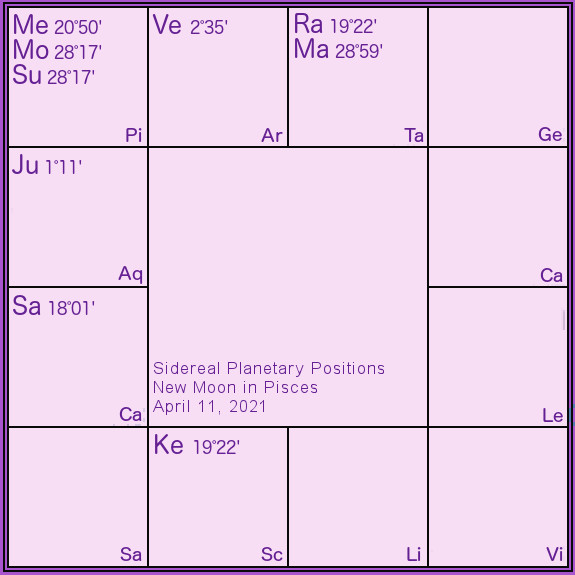
Jupiter Transit
Jupiter has moved from sidereal Capricorn into Aquarius, lightening his load as he is no longer in his sign of debilitation and joining the heavy presence of Saturn. Jupiter in Aquarius could stimulate some expansion in social programs, scientific innovations, and forward-thinking across society. This new position could stimulate some movement in your life depending on natal planetary positions and the current dasha (planetary period) and bhukti (sub-period) you are running according to your chart.
Mars Transit
Mars will leave Taurus just hours after the New Moon, finally parting ways with Rahu, lessening some of the intensity that has built up around their conjunction the past couple of months. His movement will also break the Kala Sarpa cycles, although with only one outlier the nodal alignment can still bring some intensity to current events or those born with these placements in the birth chart.
Chaitra Navaratri
This New Moon is followed by nine nights that are the springtime celebration of the goddess known as Chaitra Navaratri. These nights are celebrated in homage to the divine mother in her many forms, particularly Durga. This is not as largely celebrated as the fall-time Navaratri (Sharad or Maha Navaratri), but is also significant. This leads us up to Hanuman Jayanti which will be celebrated around the time of the next full Moon.
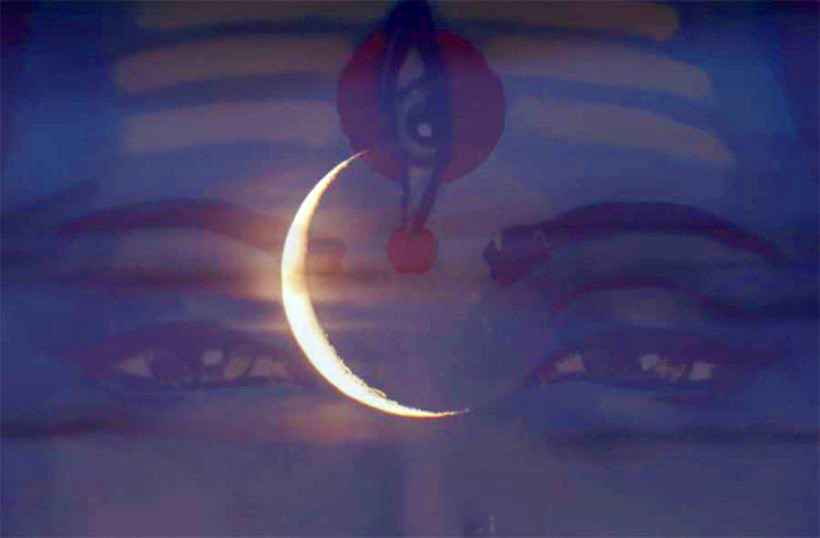
by Somya Devi | Mar 11, 2021 | Astrology, Conjunctions, Holy Days
New Moon and Maha Shivaratri, March 2021
The Sun and Moon join near the end of sidereal Aquarius on the dark night of March 12th, with an exact alignment under the New Moon at 5:21 am ET on Saturday, March 13th. Mercury and Venus also join the Moon and Sun in Aquarius, while Saturn (with Jupiter in sidereal Capricorn) once again rules over 6 grahas at the time of the New Moon. Mars and Rahu continue their conjunction in sidereal Taurus, opposite Ketu in Sagittarius, forming a Kala Sarpa Yoga in the sky. Thursday night, the fourteenth night of the waning Moon, marks the Maha Shivaratri celebration this month. Sun and Moon begin this cycle in the Vedic nakshatra Purva Bhadrapada, an auspicious sign for spiritual advancement.
Aquarius Cycle
With the new lunar cycle beginning in Aquarius, the coming month may have a quirky and forward-thinking tone, and we may see some scientific advances this month. The Mars Rover landing actually occurred just days after the Sun had entered its Aquarius cycle. Aquarius is in fact very much about service to the greater good. With Saturn strong in his own sign, we could see many significant advances in social support structures right now.
Aquarius is known as Kumbha in Sanskrit, a word for “pitcher” or “vessel.” According to the Vedic texts, the sign Kumbha can be imagined as a man holding a pot, with deep-brown skin, standing in the water. We can see this Aquarian imagery in the sadhus of India (and its biggest ritual pilgrimage day, the Kumbha Mela), who make their lives an offering of service to society through their prayers and Saturnian austerities, while renouncing the individual self. In the Aquarius cycle, we think about how we can serve the whole.
Maha Shivaratri
Thursday night, March 11th in North America, the night prior to the Dark Moon night, is the fourteenth waning phase of the lunar cycle. During this month this night is celebrated as Maha Shivaratri. This is the most auspicious night of the year for doing sadhana (spiritual practice). It is traditional on this night to stay up all night fasting, chanting, praying, and meditating. This holiday honors Lord Shiva, the great ascetic, as we recall two stories of great sacrifices that he made protect the entire creation.
One of these is the story of the gods and demons churning of the milk ocean in order to release the nectar of immortality. Before the nectar came up, however, a poison came up first. (This is similar to when we do spiritual practice and begin our path of self-inquiry, and negative tendencies often come to light first, which can be a painful experience. Similarly, during a physical fast or cleanse, toxins can be shaken loose and released first, causing a healing crisis before we continue healing into a freer, happier state of being.) When the poison came up from the milk ocean, Lord Shiva consumed it so that it would not engulf humanity, as a great and noble sacrifice. His wife, Parvati, however, held his throat so that he could not ingest it, thus saving him from being harmed by the poison.
Maha Shivaratri also commemorates the wedding of Shiva and Parvati, which also stemmed from great sacrifice made for the benefit of all humanity. It was said that after his first wife, Sati, perished, Shiva was fully devoted only to his sadhana, meditating for aeons in isolation and renouncing the world. Then the demon Tarakasura began running amock on earth, threatening all of humanity. Brahma foretold that only Shiva’s child could defeat Tarakasura, so the gods devised a plan for Sati to reincarnate as Parvati, and win over her Lord to marriage once again to produce this heir. Shiva was not easily swayed, however, and it was only after Parvati became an ascetic and underwent great penance that he agreed to marry. They eventually produced their son Kartikkeya, who went on to slay the demon.
Thus, this holiday is celebrated through the penance of fasting, forgoing food, water, and sleep, for one night, and simultaneously celebrating the union of Lord Shiva and Parvati, or the masculine and feminine energies of creation, that allows the dance of life to continue. It is an apt time to feel the forces of Aquarius upon us, which compel us to consider our role in society, and in the universe, and what personal sacrifices we can make for the greater good. Even if you’re not able to stay up the whole night, any amount of devotional practice, serviceful sacrifice, or chanting of Om Namah Shivaya on this night can have beneficial affects that are magnified greater than on any other night.
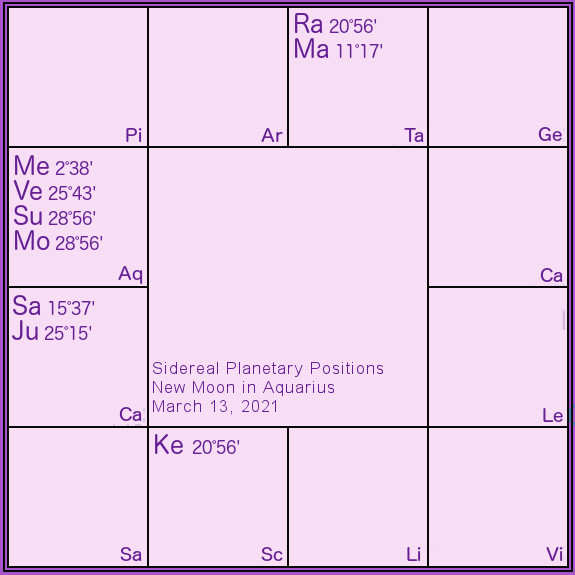
Kala Sarpa Yoga
This year’s Kala Sarpa yoga cycles continue, as Rahu and Ketu appear to cut the sky in half with all planets to one side of the nodal axis. Kala Sarpa can be translated as “black snake” or the “serpent of time,” and intensifies subtle forces on all levels, including inner challenges as well as strengths and yogic combinations in a chart. Mars joins Rahu in Taurus, and tho he will transit out of Taurus and into Gemini in one month, technically breaking the cycle, the intensity brought on by the alignment can sometimes continue when only one planet has crossed to the other side of the sky.
Purva Bhadrapada
The former “lucky-footed one” is the Vedic nakshatra (star-sign) where Sun and Moon begin this lunar cycle. This nakshatra bridges Aquarius and Pisces and is often represented by a funeral cot, symbolizing the transition from life into death, or ultimate liberation. It is ruled by Aja Epakada, the one-footed goat who is often associated with the image of Lord Shiva as Nataraj dancing on one foot, a fitting image for Maha Shivaratri.
Om Namah Shivaya!
Personal Chart Readings with Coaching Are Available Here

by Somya Devi | Jan 12, 2021 | Astrology, Holy Days
New Moon January 2021
We have another Dark Moon tonight under which the Sun and Moon align at the very end of one sign (Sagittarius), setting the tone for a month that blends and bridges the energy of two signs as the Sun spends most of this cycle in sidereal Capricorn. The exact New Moon moment is at midnight Eastern time on January 13th (between January 12th and 13th), with the Sun and Moon coming together at 29 degrees and 6 minutes of sidereal Sagittarius. The last lunar cycle began in December with a solar eclipse as the Sun and Moon joined in the very end of sidereal Scorpio.
Sagittarius-Capricorn cycle
With the New Moon moment happening in Sagittarius, hours before both Sun and Moon transit into Capricorn, the coming month will carry the energy of both signs. Sagittarius is a fire sign ruled by Jupiter, inspiring us to act on our beliefs and put these into the world through righteous action, standing up for what we believe in and aligning our actions with our vision.
This lunar cycle frees us from the energy of the eclipses of this cycle. When Sun moves into Capricorn, however, we will continue to feel the pressure of Saturn that has been strong over the last year while he has been transiting his own sign. Sun, Jupiter and Saturn will all be joined in Capricorn over the next month (with Mercury and Venus both spending much of it there as well). As Jupiter and Saturn become combust (they are now so close to the Sun as to be barely visible), they may lose some power… The sense of restriction that we feel could be alleviated this month, but our ability to be steadfast and endure difficulties is also weakened, as well as our sense of inspiration with Jupiter going out of sight.
Capricorn energy is about finding stability and the inner strength to work hard for our responsibilities and the structures that sustain us. A feminine earth sign, we can look towards our internal resources this month and make sure we are using our energy for what is most important.
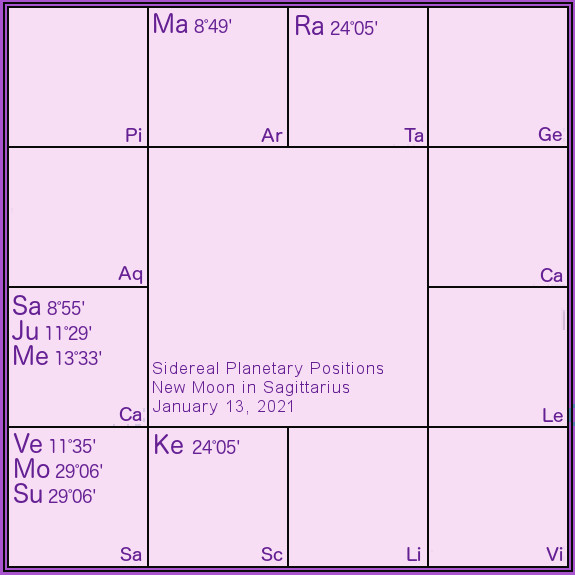
US Politics
The solar eclipse of the last cycle led into a full Moon in Ardra nakshatra, a star that often brings violence and turbulence forward, especially when associating with the nodes or an eclipse. The violence at the US Capitol during the waning part of the last cycle could be associated with the tone under which the cycle began (dark eclipse energy in transformative Scorpio), combined with the subsequent full Moon in Ardra, still afflicted by the energy of the eclipse.
As the natural 10th sign, Capricorn in the world chart directly relates to government. With four planets here in the coming days (Juipter, Saturn, Sun, and Mercury), there is a lot of pressure (Saturn) on now to create a government, structures, and leaders that will sustain the world, be inspiring, and purify the energy of authority. This bodes well for the US presidential transition in general. On January 20th Moon will be in Ashwini, the first nakshatra, a good placement for transitions.
He will, however, be joining Mars, who is the brightest planet in the sky over the next few weeks. With Mars bright and Saturn and Jupiter nearly out of sight, there is definitely potential for more violence to come (especially having the Moon joined Mars on January 20th itself). Saturn becomes highly combust that day as he goes within 3 degrees of the Sun, which cripples authority structures a bit, as well as our ability to use restraint. Hopefully the powerful energy of the Sun itself in the 10th house of this day’s world chart (and Moon chart) is enough to bring a sattvic purifying energy to the realm of government, with help from Jupiter who is neecha bangha and slightly brighter than Saturn.
Makara Sankranti
The day the Sun goes into Capricorn (January 13th/14th) begins the Hindu solar month of Makara. There is a Hindu celebration in India in honor of “the return of the light,” as we begin the first month after the winter solstice. This is an auspicious time for new beginnings and calling blessings into our lives.











